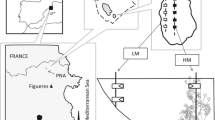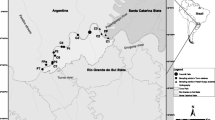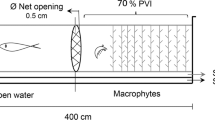Abstract
Horizontal migrations of zooplankton between macrophyte patches and open areas were investigated in the sparsely vegetated littoral zone of the Sulejow Reservoir in June-July 2000 and 2001, using one-litre plastic traps. Large-bodied zooplankton: daphnids and copepods generally swam towards the open water at dusk and towards submerged macrophytes at dawn. Small-bodied zooplankton (Bosmina sp., Chydorus sp.) did not show any pattern of horizontal movement. At the time of the research the phytoplankton community was dominated by eatable diatoms (Cyclotella sp.), whose biomass reached 14 mg l−1. Thus, bottom-up forces (food scarcity) are not likely to be responsible for the observed zooplankton migrations. Analyses of fish stomach contents showed high contribution of large zooplankters to the food of juvenile roach (Rutilus rutilus) and perch (Perca fluviatilis) which densely inhabited the littoral zone of reservoir. High fish pressure in the littoral zone along with high density of the predatory cladoceran, Leptodora kindtii in the open water, suggest that top-down forces (predatory pressure) were responsible for the migration of large zooplankton. At dusk predatory pressure of fish fry exceeded that of L. kindtii, forcing endangered zooplankton to escape from macrophytes towards open water. The opposite situation occurred at dawn. The consequences of the relationships for both zooplankton and fish fry communities dynamics are discussed.
Similar content being viewed by others
References
Bergman, E., 1990. Effect of roach, Rutilus rutilus, on two percids, Perca fluviatilis and Gymnocephalus cernua: importance of species interactions for diet schifts. Oikos 57: 241–249.
Brancelj, A. & A. Blejec, 1994. Diurnal vertical migration of Daphnia hyalina Leydig, 1860 (Crustacea: Cladocera) in Lake Bled (Slovenia) in relation to temperature and predation. Hydrobiologia 284: 125–136.
Burks, R., E. Jeppesen & D. M. Lodge, 2001. Pelagic prey and benthic predators: impact of odonate predation on Daphnia. J. North Am. Benthol. Soc. 20: 615–628.
Carpenter, S. R. & D. M. Lodge, 1986. Effects of submersed macrophytes on ecosystem processes. Aquat. Bot. 26: 341–370.
Dagg, M. J., 1985. The effects of food limitation on diel migratory behaviour in marine zooplankton. Arch. Hydrobiol. Beih. Ergebn. Limnol. 21: 247–255.
Davies, J., 1985. Evidence for a diurnal horizontal migration in Daphnia hyalina lacustris Sars. Hydrobiologia 120: 103–105.
Desmarias, K. H. & A. J. Tessier, 1999. Performance trade-off across a natural resource gradient. Oecologia 120: 137–146.
Frankiewicz, P., K. Dabrowski & M. Zalewski, 1996. Mechanism of establishing bimodality in a size distribution of age-0 pikeperch, Stizostedion lucioperca (L.) in the Sulejow Reservoir, Central Poland. Ann. Zool. Fennici 33: 321–327.
Gliwicz, Z. M. & A. Rykowska, 1992. "Shore avoidance" in zooplankton: a predation induced behaviour or predation induced mortality? J. Plankton Res. 14: 1331–1342.
Greenberg, A. E., L. S. Clesceri & A. D. Eaton, 1992. Standard methods for the examination of water and wastewater. American Public Health Association 18th ed., Washington 10.11–10.13.
Herzig, A. & B. Auer, 1990. The feeding behaviour of Leptodora kindti and its impact on the zooplankton community of Neusiedler See (Austria). Hydrobiologia 198: 107–117.
Hjelm, J., R. Svanback, P. Bystrom, L. Persson & E. Wahlstrom, 2001. Diet-dependent body morphology and ontogenetic reaction norms in Eurasian perch. Oikos 95: 311–323.
Horppila, J., 1997. Diurnal changes in the vertical distribution of cladocerans in a biomanipulated lake. Hydrobiologia 345: 215– 220.
Huntley, M. & E. R. Brooks, 1982. Effects of age and food availability on diel vertical migration of Calanus pacificus. Mar. Biol. 71: 23–31.
Jeppesen, E., 1998. The ecology of shallow lakes – trophic interactions in the pelagial.NERI Report 247. Ministry of Environment and Energy, National Environmential Research Institute, Silkeborg, Denmark: 358 pp.
Johnsen, G. H. & P. J. Jacobsen, 1987. The effect of food limitation on vertical migration in Daphnia longispina. Limnol. Oceanogr. 32: 873–880.
Kitchell, J. F., R. V. O'Neill, D. Webb, G. W. Gallepp, S. M. Bartell, J. F. Koonce & B. S. Ausmus, 1979. Consumer regulation of nutrient cycling. Bioscience 29: 28–34.
Lampert, W., 1993. Ultimate causes of diel vertical migration of zooplankton: new evidence for the predator-avoidance hypothesis. Arch. Hydrobiol. Beih. Ergebn. Limnol. 39: 79–88.
Lauridsen, T. L. & I. Buenk, 1996. Diel changes in the horizontal distribution of zooplankton in two shallow eutrophic lakes. Arch. Hydrobiol. 137: 161–176.
Lauridsen, T. L., E. Jeppesen, M. Sondergaard & D. M. Lodge, 1997. Horizontal migration of zooplankton: predator-mediated use of macrophyte habitat. In Jeppesen, E., M. Sondergaard, M. Sondergaard & K. Christoffersen (eds), The Structuring Role of Submerged Macrophytes in Lakes. Ecological Studies, New York, Springer Verlag 131: 233–239.
Lunte, C. C. & C. Luecke, 1990. Trophic interactions of Leptodora in Lake Mendota. Limnology and Oceanography 35: 1091–1100.
Persson, L., 1987. Effects of habitat and season on competitive interactions between roach (Rutilus rutilus) and perch (Perca fluviatilis). Oecologia 73: 170–177.
Pijanowska, J. & P. Dawidowicz, 1987. The lack of vertical migration in Daphnia: the effect of homogeneously distributed food. Hydrobiologia 148: 175–181.
Pinkas, L., M. S. Oliphant & I. L. K. Iverson, 1971. Food habits of albacore, bluefin tuna and bonito in Californian waters. California Fish and Game 152: 1–105.
Post, J. R., M. R. S. Johannes & D. J. McQueen, 1997. Evidence of density-dependent cohort splitting in age-0 yellow perch (Perca flavescens): potential behavioural mechanisms and populationlevel consequences. Can. J. Fish. Aquat. Sci. 54: 867–875.
Stich, H. B. & W. Lampert, 1981. Predator evasion as an explanation of diurnal vertical migration by zooplankton. Nature 293: 396– 398.
Timms, R. M. & B. Moss, 1984. Prevention of growth of potentialy dense phytoplankton populations by zooplankton grazing, in the presence of zooplanktivorous fish, in a shallow wetland ecosystem. Limnol. Oceanogr. 29: 472–486.
Vuille, T., 1991. Abundance, standing crop and production of microcrustacean populations (Cladocera, Copepoda) in the littoral zone of Lake Biel, Switzerland. Arch. Hydrobiol. 123: 165–185.
Wojtal, A., P. Frankiewicz & M. Zalewski, 1999. The role of the invertebrate predator Leptodora kindti in the trophic cascade of a lowland reservoir. Hydrobiologia 416: 215–223.
Wright, D. I. & J. Shapiro, 1990. Refuge availability: a key to understanding the summer disappearance of Daphnia. Freshwat. Biol. 24: 43–62.
Zalewski, M., B. Brewinska-Zaras, P. Frankiewicz & S. Kalinowski, 1990. The potential for biomanipulation using fry communities in a lowland reservoir: concordance between water quality and optimal recruitment. Hydrobiologia 200/201: 549–556.
Zaret, T. M. & J. S. Suffern, 1976. Vertical migration in zooplankton as a predator avoidance mechanism. Limnol. Oceanogr. 21: 804– 813.
Author information
Authors and Affiliations
Rights and permissions
About this article
Cite this article
Wojtal, A., Frankiewicz, P., Izydorczyk, K. et al. Horizontal migration of zooplankton in a littoral zone of the lowland Sulejow Reservoir (Central Poland). Hydrobiologia 506, 339–346 (2003). https://doi.org/10.1023/B:HYDR.0000008627.55462.e1
Issue Date:
DOI: https://doi.org/10.1023/B:HYDR.0000008627.55462.e1




